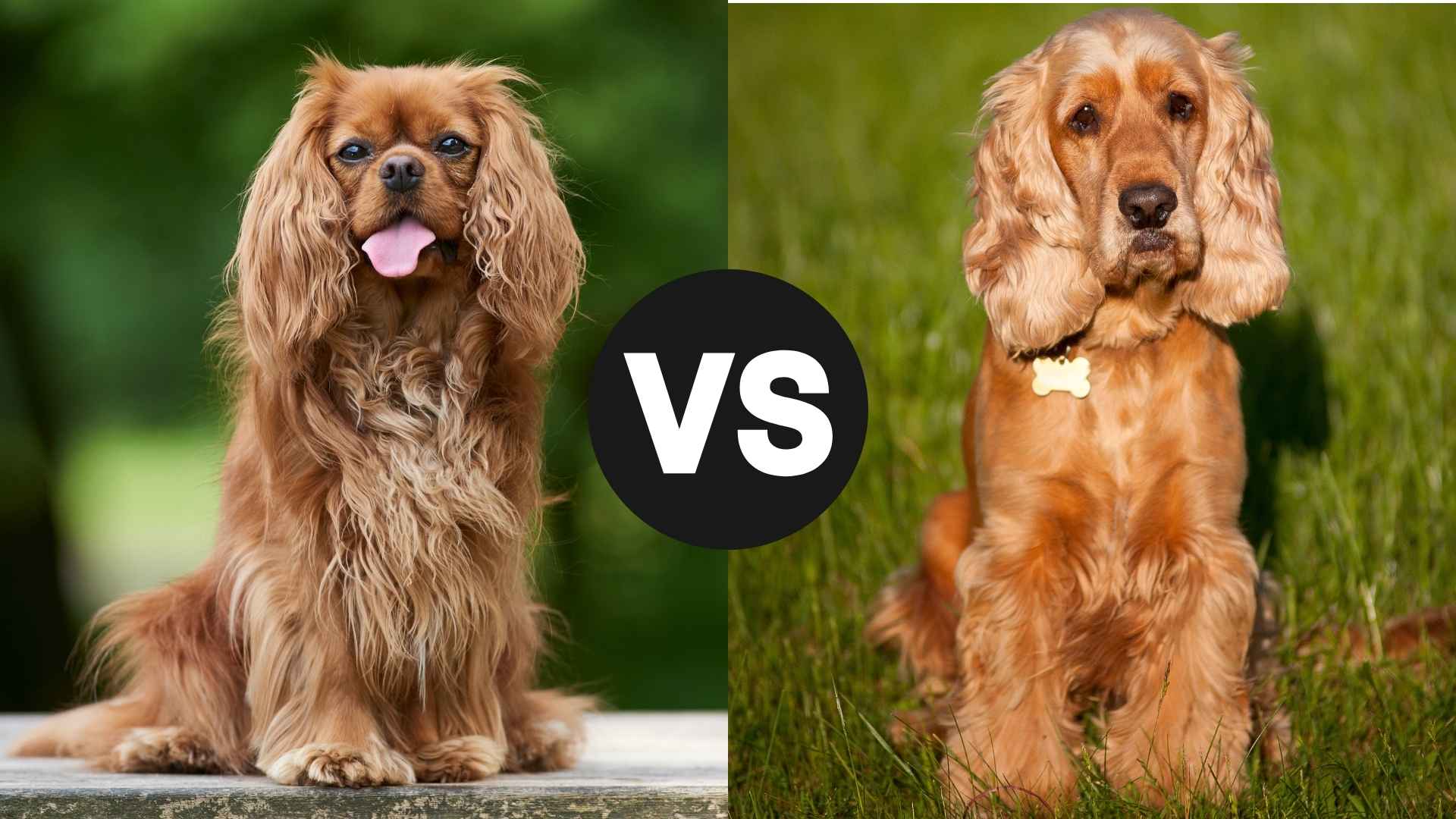Deciding between a Cavalier King Charles Spaniel and a Cocker Spaniel breed? Let’s explore these two delightful breeds together.
The King Charles Spaniel, as noted by the American Kennel Club (AKC), is a toy breed known for its friendly and affectionate. They are adaptable, whether you’re active outdoors or prefer cozy indoor settings.
On the other hand, the Cocker Spaniel, also recognized by the AKC, is a slightly larger dog that falls under the sporting group. They are energetic and thrive on activity, making them ideal for active individuals or families.
When choosing between the two, consider your lifestyle and activity level. If you desire a gentle lapdog, the Cavalier King Charles Spaniel might be your match. If you’re looking for a spirited, active buddy, the American Cocker Spaniel could be the perfect fit.
Cavalier King Charles Spaniel vs. Cocker Spaniel
Cavalier King Charles Spaniel vs. Cocker Spaniel: Comparison of Appearance
Cavaliers are small dogs, typically weighing between 13 to 18 pounds and standing 12 to 13 inches tall. In contrast, Cocker Spaniels are larger dogs, with males standing about 15 inches tall and weighing around 25 to 30 pounds.
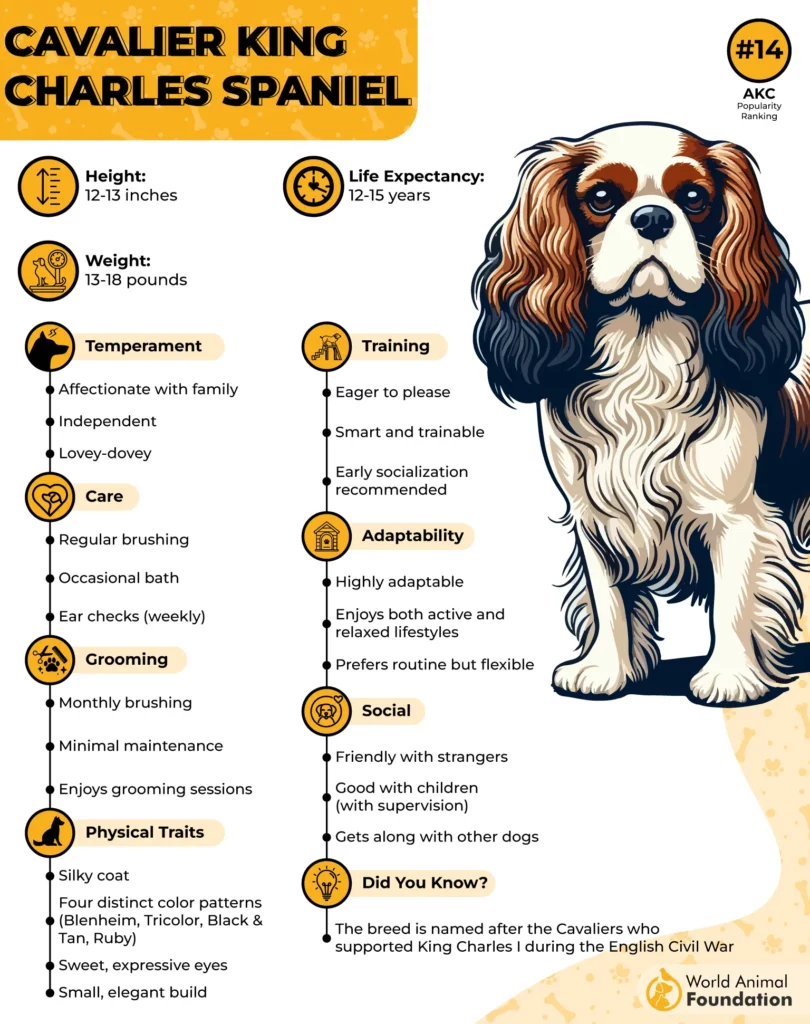
Both breeds are known for their silky coats. King Charles, a toy breed, often has medium-length fur with feathering on the ears, chest, legs, and tail, adding to their elegant appearance. Cocker Spaniels possess a more profuse coat that requires regular grooming to prevent matting.
A distinctive feature of King Charles Spaniels is their expressive, big eyes, which convey a gentle demeanor. Cocker Spaniels also have appealing eyes but are particularly noted for their long ears, which enhance their endearing look.

Both breeds are considered adorable dogs, cherished for their friendly and affectionate natures. They thrive on human companionship and are known to be excellent family pets.
In terms of coat color, King Charles Spaniels come in four standard colors: Blenheim (chestnut and white), tricolor (black, white, and tan), ruby (solid red), and black and tan. Cocker Spaniels exhibit a broader spectrum of colors and patterns, including solid colors and combinations with white markings.
Both breeds require regular grooming to maintain their silky coats. American Cocker Spaniels, with their more abundant fur, may need more frequent attention to prevent tangles and matting.
When choosing between these two breeds, consider your lifestyle and grooming commitment. King Charles are adaptable and may suit a variety of living situations, while Cocker Spaniels, being larger and more energetic, might benefit from more active households.
Cocker Spaniel vs. King Charles Spaniel: Personality and Character Comparison
When comparing the personality traits of Cavalier King Charles Spaniels and Cocker Spaniels, both breeds are affectionate dogs, making them amazing dogs to have. Cavaliers are often described as gentle and friendly, thriving on spending time with their families.
Cocker Spaniel breeds, on the other hand, are known for their merry and frolicsome temperament. They are considered one of the sweetest dogs, displaying a cheerful disposition.
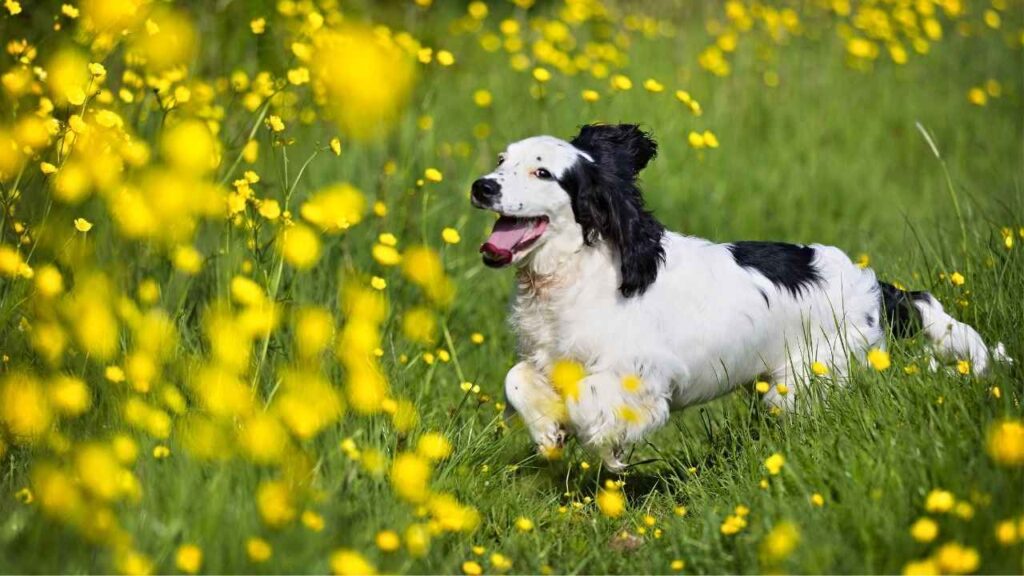
A key difference between the two breeds is their energy levels. American Cocker Spaniels exhibit higher energy and require regular exercise to stay content. King Charles Spaniels, while enjoying playtime, are more adaptable to a relaxed lifestyle.
Both breeds are sociable and get along well with children and other pets. However, Cavaliers are particularly noted for their calm demeanor, making them excellent lap dogs. American Cocker Spaniels, with their sporting background, may be more inclined toward active play.
Training is generally straightforward with both breeds due to their eagerness to please. King Charles Spaniels are attentive and respond well to gentle guidance. Cocker Spaniels are intelligent and can excel in various canine activities.
When considering a puppy, it’s essential to match their temperament with your lifestyle. King Charles Spaniels are ideal for those seeking a calm companion, while Cocker Spaniels suit active individuals.
Both dog breeds are delightful companions. Your choice depends on whether you prefer a more relaxed or energetic canine friend.
Cocker Spaniel vs. Cavalier King Charles Spaniel: Training Comparison
Cavalier King Charles Spaniels and American Cocker Spaniels have distinct training considerations rooted in their histories. King Charles Spaniels, cherished by King Charles II, were bred as companion dog breeds, leading to a temperament that is eager to please and responsive to gentle methods.
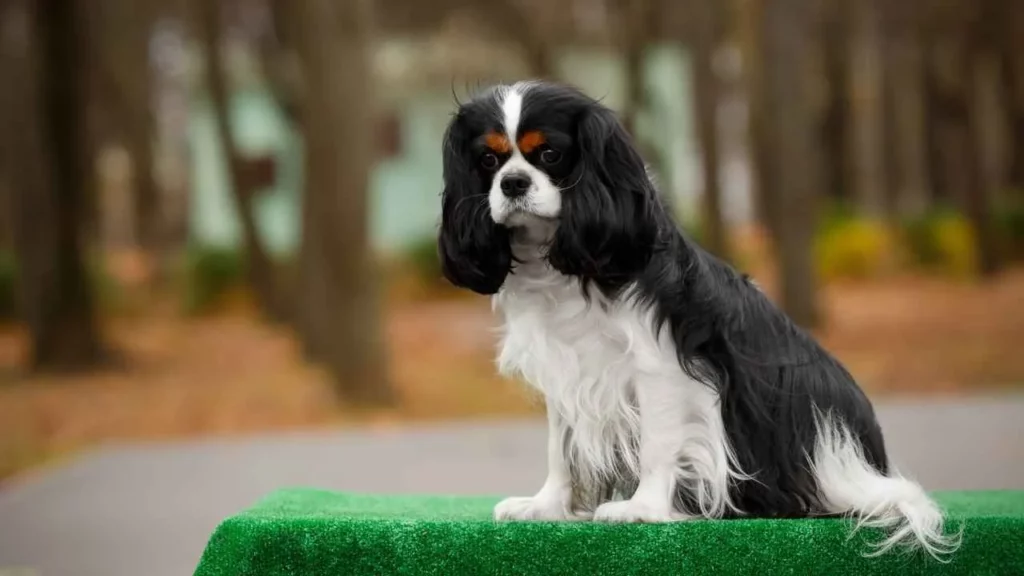
In contrast, Cocker Spaniels were originally bred as hunting dogs, specifically for bird hunting. This background contributes to their high energy levels and a need for more exercise to maintain mental and physical health.
The hunting instincts of Cocker Spaniels can influence their needs. They may require more structured activities to channel their energy effectively.
Both breeds are intelligent and trainable, but their differing backgrounds mean their exercise needs vary. Cocker Spaniels often require more physical activity, while Cavaliers are content with moderate exercise.
Early socialization is crucial for both breeds to ensure well-rounded personalities. Introducing a puppy to various environments and positive reinforcement methods can lead to a balanced temperament.
American Cocker Spaniels’ bird-hunting heritage means they may have a stronger prey drive. Training should address this instinct to prevent unwanted behaviors.

While both breeds are trainable, understanding their histories and individual needs is essential. Tailoring training approaches to each breed’s background will lead to a harmonious relationship.
Cavalier King Charles Spaniel vs. Cocker Spaniel: Health Comparison
Britannica states that Cavalier King Charles Spaniels and American Cocker Spaniels, both loving dogs, have distinct health profiles that every owner should be aware of. Cavaliers are notably prone to mitral valve disease, a heart condition that often leads to heart failure and requires lifelong monitoring.
Both breeds can experience hip dysplasia, a genetic disorder affecting hip joint development and causing pain over time. Exercise is essential to maintain joint health, but it’s crucial to balance activity to avoid overexertion and worsening the condition.
Patellar luxation, where the kneecap dislocates, is another concern for both breeds and can lead to discomfort and mobility issues. Monitoring their activity ensures they receive enough exercise without strain, preventing unnecessary stress on their joints.
Eye conditions, such as progressive retinal atrophy, are common in both breeds and can eventually lead to blindness if left untreated. Regular veterinary check-ups can aid in early detection and management, helping to slow down vision loss.
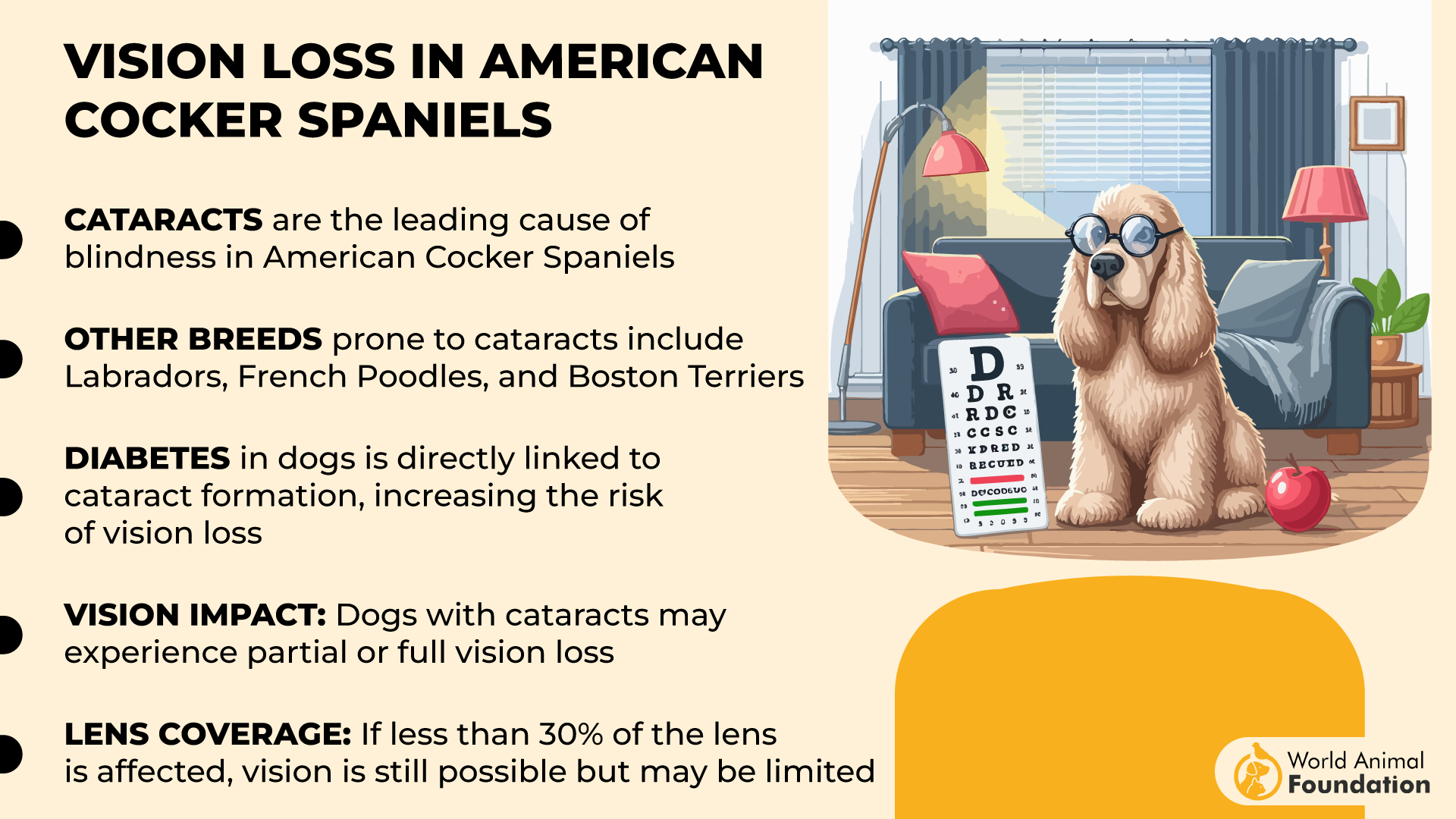
American Cocker Spaniels are particularly susceptible to ear infections due to their ear structure, which traps moisture and debris. Routine ear cleaning and proper drying after baths or swimming can help prevent these painful infections.
Maintaining a healthy weight is vital for both breeds, as extra pounds can put unnecessary stress on their joints and increase health risks. A balanced diet, portion control, and appropriate exercise routines tailored to their needs are key to their long-term well-being.
Responsible breeding practices and regular veterinary visits are essential to managing and mitigating these common health problems. Proactive care, early detection, and a well-planned lifestyle can significantly enhance the quality of life for these beloved companions.

Cavalier King Charles Spaniel vs. Cocker Spaniel: Grooming Needs Comparison
Cavalier King Charles Spaniels and American Cocker Spaniels, both excellent family dogs, have distinct grooming needs due to their physical characteristics. Cavaliers have a medium-length silky coat with feathering and tan markings, requiring regular brushing to prevent matting.
PDSA mentions that Cocker Spaniels have a more profuse coat that demands more grooming attention. Daily brushing is recommended to prevent tangles and mats, especially after outdoor activities.
Both breeds benefit from regular professional grooming sessions. For Cavaliers, visits every four to six weeks help maintain coat condition and hygiene. Cocker Spaniels may require more frequent grooming due to their denser coats.
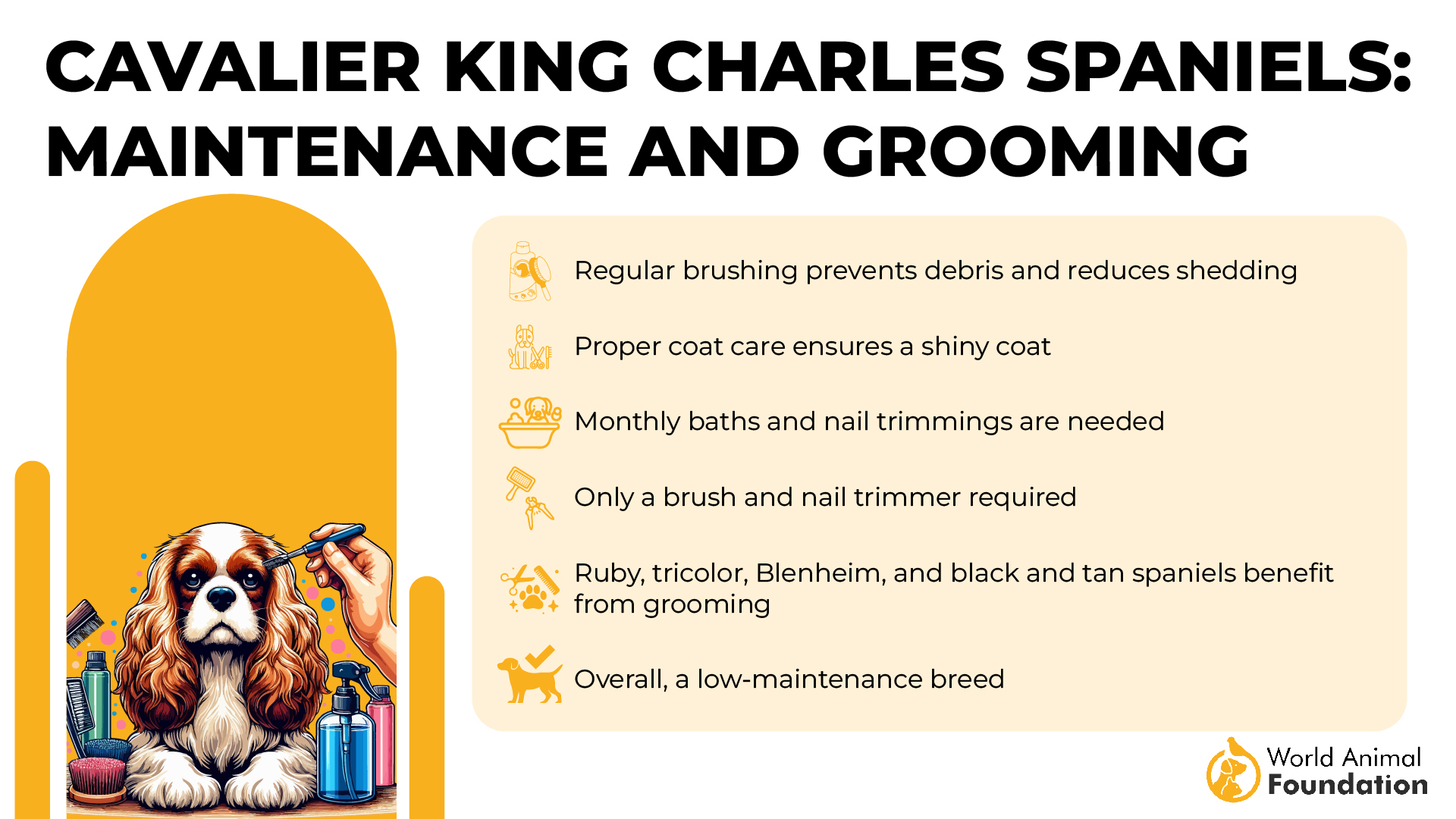
Ear care is crucial for both breeds, as their drop ears can trap moisture and debris, leading to infections. Regular cleaning is essential to maintain ear health.
Nail trimming should be part of the grooming routine for both breeds to prevent overgrowth and associated issues. Regular checks and trims are recommended.
While Cavaliers are generally moderate shedders, regular brushing helps manage shedding and keeps their coat in optimal condition. American Cocker Spaniels, with their denser coats, may shed more and require consistent grooming to manage loose hair.
Both breeds are known for their friendly dispositions and make excellent family dogs. Proper grooming not only maintains their appearance but also contributes to their overall health and comfort.
Conclusion
In the comparison between Cavalier King Charles Spaniels vs American Cocker Spaniels, understanding their health issues is crucial. Cavaliers are notably susceptible to heart disease, particularly mitral valve disease, which can significantly impact their lifespan.
Both breeds are prone to hip dysplasia, a genetic disorder affecting the hip joint, leading to discomfort and mobility challenges.
When considering a new pup, it’s essential to recognize that both breeds generally get along well with kids and other animals. Their friendly nature makes them excellent family companions.
However, potential owners should be aware of certain behavioral traits. For instance, Cocker Spaniels may exhibit excessive barking if not properly trained and socialized.
Both breeds have a history in the show ring. Their distinctive appearances and charming personalities make them popular choices as show dog breeds. You can also explore other dogs, like the English Cocker Spaniel and the English Toy Spaniel.
Regular veterinary check-ups are vital to monitor and manage any emerging health problems. Early detection can significantly improve the quality of life for these breeds.
Cavalier King Charles Spaniels and Cocker Spaniels can make wonderful additions to the right home. Prospective owners should consider health predispositions and ensure they can meet the needs of these breeds.
If you’re considering adding one of these delightful breeds to your family, consult with reputable breeders or adoption agencies. Ensure you can provide a loving and supportive environment for your new furry friend.


